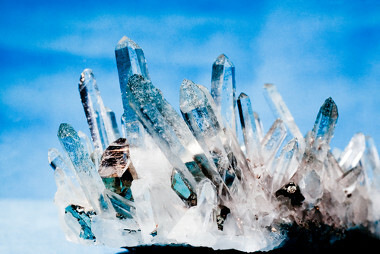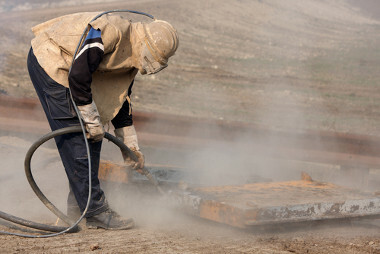THE silica is a hard compound, the silicon dioxide (SiO2), which forms macromolecules in which each silicon atom binds to four oxygen atoms, following the vertices of a regular tetrahedron, and each oxygen atom, in turn, is bonded to two silicon atoms, as shown in illustration a follow:

Silicon Dioxide Crystal Structure - Silica
This group can bind to different chemical elements and form various types of silica minerals, such as the quartz, quartzite, tridymite, crytobalite, opal, clay and sand. Silica is so present in sands and minerals that, alone or combined with other elements, it accounts for about 60% by weight of the entire earth's crust.

Quartz image, most responsible for the development of silicosis in workers
Silica is very present in several products used in our daily lives and even more in the factories and industries that produce them. The main points of contact of workers with silica are in the mining, mainly in the extraction of gold, mine, construction, where tunnels and shafts are dug, in addition to polishing facades; industry of
ceramics, metallurgy, foundry and steel industry. In all these areas, jobs such as sanding, drilling, grinding, cutting, assembling, disassembling, molding, polishing and so on, which are activities that leave the worker in contact with the silica particles that appear in the form of dust.But this contact is very dangerous! To get an idea, on February 20, 2014, the press reported that the Superintendence of the Ministry of Labor and Employment of the State of Minas Gerais held a operation that identified at least 8000 people who were working in precarious conditions in quartzite exploration companies in the city of Alpinópolis, in the state of Minas General. Worst of all, 47 of these workers were diagnosed with silicosis.
Silicosis is a disease caused exactly by the inhalation of fine particles of crystalline silica, which are absorbed by the lungs, which, in turn, react, causing the accumulation of fibrotic tissue, ie, the lung will hardening. This is, therefore, a occupational disease, that is, that it is basically developed in the work environment, when such people work in inadequate conditions.
The legislation allows a tolerance limit of 0.1mg/m³, but that doesn't mean it's a safe environment. Even at this level, silicosis can occur., which develops very slowly.
THE chronic silicosis it is the most common and appears only about 20 years after exposure to silica dust. Other forms can appear faster due to the inhalation of high concentrations of silica, manifesting in approximately 5 to 10 years. There is also the subacute silicosis and the acute, in which complications and risks are greater.
The diagnosis starts with the symptoms, which are fatigue, shortness of breath, cough, dizziness, weakness and emaciation. The physician should perform an occupational history review and perform a chest x-ray, which may indicate silicosis when small nodules appear throughout the lung tissue, with a "speckled" appearance in the plate.
Inhalation of silica dust can also lead to cancer and other lung diseases as the lung is weakened. This occurrence has already caused the disability and death of thousands of workers.
The main work activity that causes silicosis is sandblasting, shown in the following figure. THE Law No. 1,670 of 1999 prohibits sandblasting any material throughout the country. See the amount of dust that is formed and how the worker is easily exposed to its inhalation:

Sandblasting on metal structures at the construction site
Unfortunately, silicosis has no cure and may continue to evolve even after exposure to silica ceases. But workers and business owners need to be aware of the risk and how easily it can be avoided. Some actions that can be taken are:
* In the case of sand blasting, change the abrasive, that is, blasting with other products or with water;
* Exchange equipment that sands, cuts or drills dry for equipment that performs these same activities in a wet way. THE Ordinance No. 43, of March 11, 2008, from the Ministry of Labor and Employment, prohibits machines that cut or dry stone finishes. All must have water attached;
* Accomplish regular cleaning of the workplace with a vacuum, and not with a broom or any other method that further spreads the silica dust;
* Installation of exhaust ventilation system that captures the dust in the place where it is formed and prevents its spreading;
*Mechanical enclosure of equipment;
*Signaling with posters;
*do not feed in the work environment;
* don't rest or stay for a long time in a place where there may be silica dust;
* Wear personal protective equipment adequate;
* At clothes must be put on when arriving at the industry and must be washed by the company itself, that is, employees must not take them home;
* Regular measurements of the concentration of silica dust in the working environment and examinations of workers must be carried out.
By Jennifer Fogaça
Graduated in Chemistry
Source: Brazil School - https://brasilescola.uol.com.br/quimica/silica-silicose.htm
